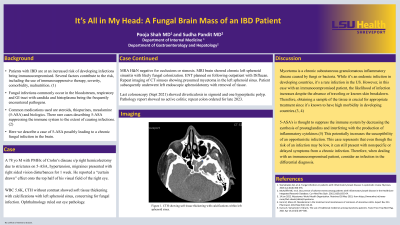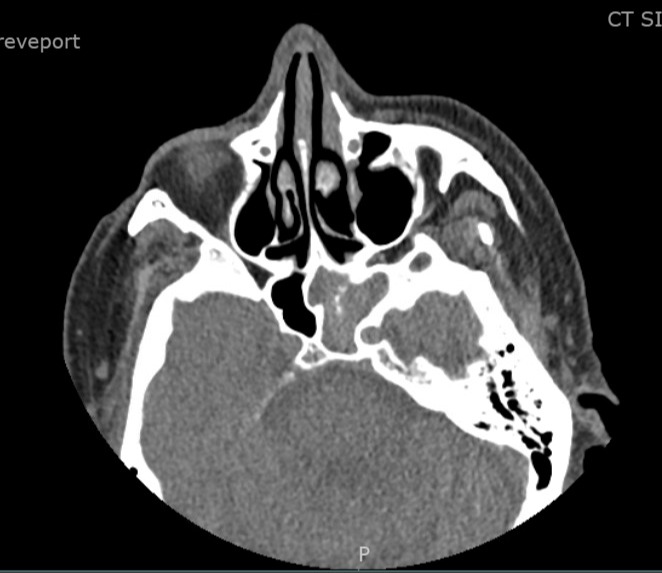Tuesday Poster Session
Category: IBD
P3650 - It’s All in My Head: A Fungal Mass Found in a Crohn’s Patient
Tuesday, October 24, 2023
10:30 AM - 4:00 PM PT
Location: Exhibit Hall

Has Audio

Pooja Shah, MD
LSU Health Sciences Center
Shreveport, LA
Presenting Author(s)
Pooja Shah, MD, Sudha Pandit, MD
LSU Health Sciences Center, Shreveport, LA
Introduction: Patients with IBD are at an increased risk of developing infections being immunocompromised. Several factors contribute to the risk, including the use of immunosuppressive therapy, severity, comorbidity, malnutrition.(1) Fungal infections commonly occur in the bloodstream, respiratory and GI tract with candida and histoplasma being the frequently encountered pathogens. Common medications used are steroids, thiopurines, mesalamine (5-ASA) and biologics.(2) There rare cases describing 5-ASA suppressing the immune system to the extent of causing infections. Here we describe a case of 5-ASA possibly leading to a chronic fungal infection in the brain.
Case Description/Methods: A 78 yo M with PMHx of Crohn’s disease s/p right hemicolectomy due to strictures on 5-ASA and migraines presented with right sided vision disturbances for 1 week. He reported a “curtain drawn” effect onto the top half of his visual field of the right eye. WBC 5.6K, CTH without contrast showed soft tissue thickening with calcifications with left sphenoid sinus, concerning for fungal infection. Ophthalmology ruled out any eye pathology. MRA H&N negative for occlusions or stenosis. MRI brain showed chronic left sphenoid sinusitis with likely fungal colonization. ENT planned on following outpatient with Diflucan. Repeat imaging of CT sinuses showing presumed mycetoma in the left sphenoid sinus. Patient subsequently underwent left endoscopic sphenoidotomy with removal of tissue.
Discussion: Mycetoma is a chronic subcutaneous granulomatous inflammatory disease caused by fungi or bacteria. While it’s an endemic infection in developing countries, it’s a rare infection in the US. However, in this case with an immunocompromised patient, the likelihood of infection increases despite the absence of traveling or known skin breakdown. Therefore, obtaining a sample of the tissue is crucial for appropriate treatment since it’s known to have high morbidity in developing countries.(3, 4)
5-ASA’s is thought to suppress the immune system by decreasing the synthesis of prostaglandins and interfering with the production of inflammatory cytokines.(5) This potentially increases the susceptibility of an opportunistic infection. This case represents that even though the risk of an infection may be low, it can still present with nonspecific or delayed symptoms from a chronic infection. Therefore, when dealing with an immunocompromised patient, consider the possibility of an infection in the differential diagnosis.

Disclosures:
Pooja Shah, MD, Sudha Pandit, MD. P3650 - It’s All in My Head: A Fungal Mass Found in a Crohn’s Patient, ACG 2023 Annual Scientific Meeting Abstracts. Vancouver, BC, Canada: American College of Gastroenterology.
LSU Health Sciences Center, Shreveport, LA
Introduction: Patients with IBD are at an increased risk of developing infections being immunocompromised. Several factors contribute to the risk, including the use of immunosuppressive therapy, severity, comorbidity, malnutrition.(1) Fungal infections commonly occur in the bloodstream, respiratory and GI tract with candida and histoplasma being the frequently encountered pathogens. Common medications used are steroids, thiopurines, mesalamine (5-ASA) and biologics.(2) There rare cases describing 5-ASA suppressing the immune system to the extent of causing infections. Here we describe a case of 5-ASA possibly leading to a chronic fungal infection in the brain.
Case Description/Methods: A 78 yo M with PMHx of Crohn’s disease s/p right hemicolectomy due to strictures on 5-ASA and migraines presented with right sided vision disturbances for 1 week. He reported a “curtain drawn” effect onto the top half of his visual field of the right eye. WBC 5.6K, CTH without contrast showed soft tissue thickening with calcifications with left sphenoid sinus, concerning for fungal infection. Ophthalmology ruled out any eye pathology. MRA H&N negative for occlusions or stenosis. MRI brain showed chronic left sphenoid sinusitis with likely fungal colonization. ENT planned on following outpatient with Diflucan. Repeat imaging of CT sinuses showing presumed mycetoma in the left sphenoid sinus. Patient subsequently underwent left endoscopic sphenoidotomy with removal of tissue.
Discussion: Mycetoma is a chronic subcutaneous granulomatous inflammatory disease caused by fungi or bacteria. While it’s an endemic infection in developing countries, it’s a rare infection in the US. However, in this case with an immunocompromised patient, the likelihood of infection increases despite the absence of traveling or known skin breakdown. Therefore, obtaining a sample of the tissue is crucial for appropriate treatment since it’s known to have high morbidity in developing countries.(3, 4)
5-ASA’s is thought to suppress the immune system by decreasing the synthesis of prostaglandins and interfering with the production of inflammatory cytokines.(5) This potentially increases the susceptibility of an opportunistic infection. This case represents that even though the risk of an infection may be low, it can still present with nonspecific or delayed symptoms from a chronic infection. Therefore, when dealing with an immunocompromised patient, consider the possibility of an infection in the differential diagnosis.

Figure: Soft tissue density mass with scattered calcifications within the left sphenoid sinus suggestive of mycetoma.
Disclosures:
Pooja Shah indicated no relevant financial relationships.
Sudha Pandit indicated no relevant financial relationships.
Pooja Shah, MD, Sudha Pandit, MD. P3650 - It’s All in My Head: A Fungal Mass Found in a Crohn’s Patient, ACG 2023 Annual Scientific Meeting Abstracts. Vancouver, BC, Canada: American College of Gastroenterology.
